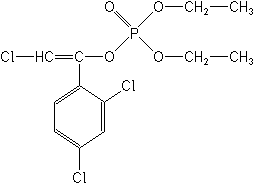-
Common NameChlorfenvinphos
-
中文通用名毒虫畏
-
IUPAC(EZ)-2-chloro-1-(2,4-dichlorophenyl)vinyl diethyl phosphate
-
CAS2-chloro-1-(2,4-dichlorophenyl)ethenyl diethyl phosphate
-
CAS No.470-90-6
-
Molecular FormulaC12H14Cl3O4P
-
Molecular Structure
-
Category
-
ActivityInsecticide, acaricide
-
Physical PropertiesMolecular weight:359.6; Physical form:Colourless liquid; (tech., amber liquid). Density:1.36 at 20 °C; Composition:Tech. grade ( 90% (Z)- and (E)- isomers), typical ratio (Z):(E) 8.6:1. The dimethyl ester analogue is chlorfenvinphos-methyl ( q.v.). Melting point:-23 to -19 °C; Vapour pressure:1 mPa (25 °C); 0.53 mPa (extrapolated to 20 °C); Partition coefficient(n-octanol and water):logP = 3.85 ((Z)- isomer), 4.22 ((E)- isomer); Solubility:In water 145 mg/l (23 °C). Miscible with most common organic solvents, e.g. ethanol, acetone, dichloromethane, hexane, xylene, propylene glycol, kerosene.; Stability:Hydrolysed slowly in neutral, acidic, and slightly alkaline aqueous solutions. Hydrolysed rapidly in strongly alkaline solutions. DT50 (38 °C) >700 h (pH 1.1), >400 h (pH 9.1); (20 °C) 1.28 h. Miscible with organic solvents.
-
ToxicologyOral:Acute oral LD50 for rats 10 mg/kg, mice 117-200 mg/kg, rabbits 300-1000 mg/kg, dogs >12 000 mg/kg. Percutaneous:Acute percutaneous LD50 for rats 31-108 mg/kg, rabbits 400-4700 mg/kg. Non-irritating to skin and eyes (rabbits). Inhalation:LC50 (4 h) for rats c. 0.05 mg/l air. Phytotoxicity:Non-phytotoxic when used as directed. Some injury may occur if applied directly to the seeds of certain crops.
-
Environmental ProfileEcotoxicology:
Bees:LD50 (24 h) (oral) 0.55mg/bee; (topical) 4.1 mg/bee.Birds:Acute oral LD50 for pheasants 107, pigeons 16 mg/kg.Daphnia:LC50 (48 h) 0.3 mg/l.Fish: LC50 (96 h) for harlequin fish <0.32, guppies 0.3-1.6 mg/l.
Environmental fate:
Animals:Primary metabolic detoxification is by de-esterification to give 2-chloro-1-(2,4-dichlorophenyl)vinyl ethyl hydrogen phosphate. Ultimate metabolites include the glucuronides of 2,4-dichlorophenylethanediol and 1-(2,4-dichlorophenyl)ethanol, and N-(2,4-dicPlant:Metabolism is similar to that in mammals; see K. I. Beynon, Residue Rev., 1973, 47, 55. WATER SOLUBILITY: 145 ppm at 23°C.
-
Transport InformationSignal Word:DANGER-POISON; Hazard Class:Ia(Extremely hazardous)
Porduct NewsMore
Glyphosate price plummets 40% in one year in Argentina
Indian govt stops imports of herbicide Glufosinate priced below Rs 1,289 per kg
Carbendazim fungicide wins victory in Brazilian Parliament
Corteva presents new pre-emergent herbicide Linear for sugarcane in Brazil
Picloram Triclopyr Aminopyralid
Revolutionizing disease prevention: BASF launches new rice fungicide Cevya® in China
Thiamethoxam is allowed again in Brazil by a judicial decision
Bayer develops alternative to glyphosate herbicide
Colombia’s Constitutional Court bans chlorpyrifos
ADAMA Canada moves forward with lambda-cyhalothrin sales for 2023

 0
0 Subscribe
Subscribe
